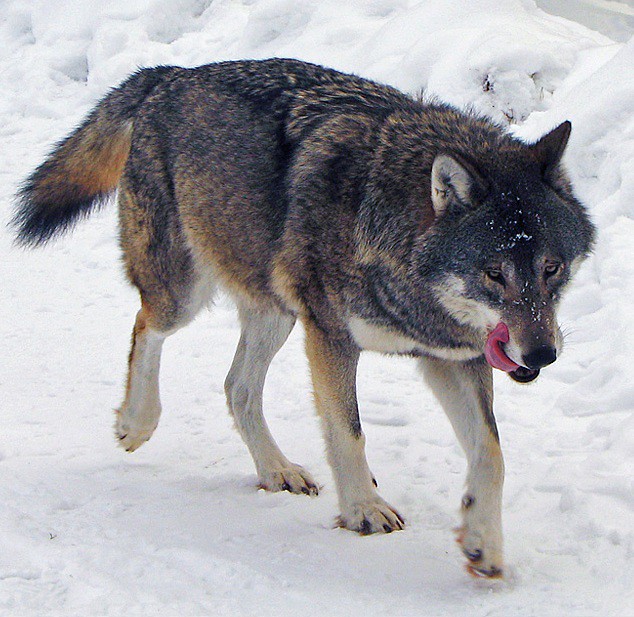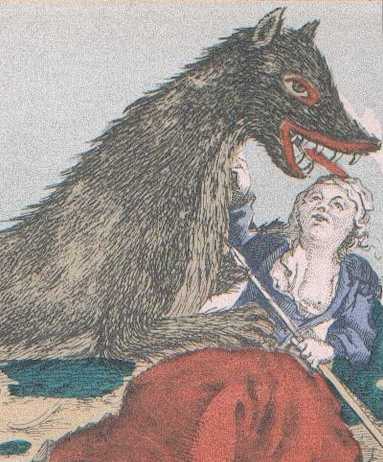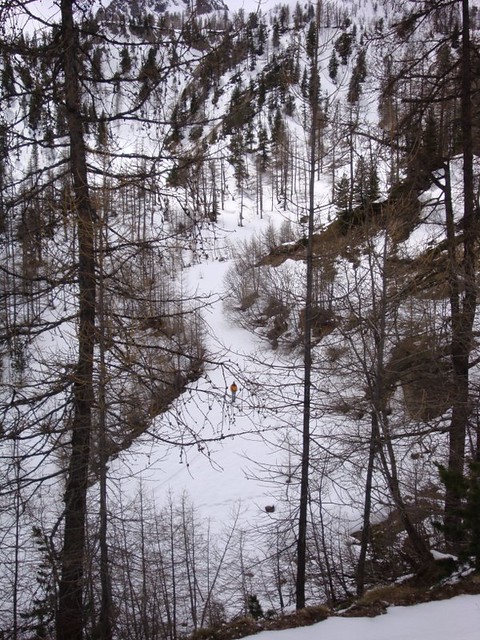Wolves in France (Les loups en France)
“It’s the gentle wolves who are the most dangerous,” warns the first printed version of Red Riding Hood (Le Petit Chaperon Rouge) by Charles Perrault in 1697. The moral of this much darker version of the well-known fairy tale is that young women mustn’t talk to strangers. Perrault shows what happens to them if they do – the story ends with the pretty, innocent girl eaten up.
We all know who does the eating.
Wolves appear in other French legends and they’re never nice. An example is the man-eating wolf-like animal that terrorised the former province of Gévaudan (now part of Haute-Loire) in La Bête du Gévaudan. And, of course, the fact that wolves kill livestock doesn’t help their reputation.
So Alpha, Le Parc des Loups, in the Haute Provence region of France, which aims to reconcile wolves and humans, doesn’t have an easy job.
In the small village of Le Boréon, 5km from Saint Martin Vésubie, Alpha is a 90 minute drive from Nice, along roads with stunning mountain views. It’s on the edge of the Mercantour National Park, where wild wolves roam, although you’d be lucky to see one in the wild since they’re incredibly wary of humans and strictly nocturnal.
Wolves were hunted to extinction in France in the 1920’s. But in 1992, packs from Italy started crossing the Maritime Alps into Mercantour. The animals are now protected. Despite high-profile protests from sheep farmers, the population has grown, with estimates of up to 180 wolves now living in France.
Gaston Franco, the mayor of Saint-Martin Vésubie, explains Alpha is not intended as a zoo. It was established in 2005 to show the pros and cons of the reintroduction of wolves into France. He says, “We weren’t prepared and living with this wild animal has rekindled feuds we had believed were forgotten.”
There are 22 wolves living in the ten hectare park, in a natural setting and in relative freedom, although they are fed and cared for. The wolves live in three distinct packs.
“We want to inform people about co-habiting with wolves,” I was told by Nicolas, one of the enthusiastic, friendly staff at the park. “When people know more about these animals, they are less frightened.”
Visitors view the wolves from the safety of glassed-in hides. I stood there for ages watching a pack as they ran among trees and rocks. I must admit they didn’t look as scary as I’d expected, more like big dogs with soft coats. I found myself imagining how nice they would be to stroke, until the keepers arrived with baskets of dead chickens and the wolves started fighting over the food…
Even more interesting was seeing the ‘scenovisions’ (animated projections) which were shown in the renovated mountain stables. The projections presented the view of scientists, shepherds and wolf hunters and were an excellent way to present these different points of view.
I learned that French attitudes to wolves have been shaped in part by the negative way these animals have been portrayed in legends and stories. In Italy, where the legend of Romulus and Remus depicts a she-wolf as a life-saver, fear and hatred of wolves aren’t as strong. The presentations also helped me understand that the return of wolves to France is seen by mountain shepherds as yet another challenge in their already difficult lives.
I’m told wolves don’t readily bite humans and that you’re more likely to be struck by lightning than to be attacked by a wolf. But I think I’ll keep in mind Charles Perrault’s warning and always be wary of gentle-looking wolves…
For more information: http://www.alpha-loup.com
Image credit: Wolf in snow by Daniel MottLes loups en France
Traduction par Agnès Landou
La première version imprimée du Petit Chaperon Rouge ( Red Riding Hood ) de Charles Perrault en 1697 nous met en garde : « Ce sont les loups les plus doucereux les plus dangereux . »
La morale de cette sombre version du conte de fées bien connu est que les jeunes femmes ne doivent pas parler aux étrangers. Perrault nous montre ce qu’il advient lorsqu’elles le font – l’histoire se termine avec la jolie et innocente jeune fille dévorée.
Nous savons tous qui l’a mangée !
Les loups apparaissent dans d’autres histoires françaises et ils ne sont jamais sympathiques !
Un exemple en est de cet animal semblable à un loup dévoreur d’hommes qui a terrorisé l’ancienne province du Gévaudan (aujourd’hui département de la Lozère et d’une partie de la Haute Loire) dans la Bête du Gévaudan. Et bien sûr le fait que les loups tuent le bétail n’œuvre pas en leur faveur. Aussi, Alpha, le Parc des loups dans la région de Haute Provence en France, qui vise à réconcilier loups et humains n’a pas la tâche facile.
Dans le petit village « Le Boréon », à 5 kilomètres de Saint Martin Vésubie, Alpha est à 1 heure 30 de route de Nice, avec tout au long des vues imprenables sur la montagne. C’est près du Parc National de Mercantour qu’errent les loups… bien qu’il faille que vous ayez de la chance pour en voir un dans la nature car ils se méfient des humains et ce sont des animaux nocturnes.
Les loups ont été chassés en France jusqu’à leur extinction dans les années 20. Mais en 1992, des bandes de loups venant d’Italie ont traversé les Alpes Maritimes vers Mercantour. Les animaux sont maintenant protégés. Malgré les protestations des éleveurs de moutons, leur nombre a augmenté avec des estimations allant jusqu’à 180 loups vivant actuellement en France.
Gaston Franco, le Maire de St Martin Vésubie explique qu’Alpha n’est pas conçu en tant que zoo. Il a été ouvert en 2005 pour montrer les avantages et les inconvénients de la réintroduction des loups en France. Il dit : « Nous n’y étions pas préparés et la cohabitation avec cet animal sauvage a rallumé des querelles que l’on croyait oubliées. »
Il y a 22 loups qui vivent dans un parc de 10 hectares dans un cadre naturel et en semi-liberté, bien qu’ils y soient nourris et soignés. Les loups vivent dans trois bandes distinctes.
« Nous voulons informer les gens à propos de la cohabitation avec les loups » m’a dit Nicolas un des employés sympathique et enthousiaste du parc. « Quand les gens en sauront davantage sur ces animaux ils en seront moins effrayés ».
Les visiteurs regardent les loups en toute sécurité derrière des vitres sans tain. Je suis restée là pendant longtemps à en regarder une bande courir entre les arbres et les rochers. Je dois avouer qu’ils n’ont pas l’air aussi effrayant que ce que j’avais pensé. Ils ressemblaient plutôt à de gros chiens au doux pelage. Je m’imaginais caressant leur fourrure, mais les gardiens sont arrivés avec des paniers de nourriture (des poulets) et les loups ont commencé à se battre. J’ai alors changé d’avis !
Encore plus intéressant est de voir les projections animées qui ont été présentées dans les écuries rénovées. Les projections présentaient le point de vue des scientifiques, des bergers et des chasseurs de loups et sont un excellent moyen de montrer ces points de vue très différents.
J’ai appris que les attitudes des Français par rapport aux loups ont été façonnées par le côté négatif selon lequel ils ont été dépeints dans les légendes et histoires.
En Italie où la légende de Romulus et Rémus représente une louve comme une bouée de sauvetage, la peur et la haine du loup ne sont pas aussi fortes. Les présentations m’ont aussi aidée à comprendre que le retour du loup en France est considéré par les bergers comme un problème supplémentaire à leur condition de vie déjà difficile.
J’ai entendu dire que les loups ne mordent pas souvent les humains et que vous risquez davantage d’être frappé par la foudre que d’être attaqué par un loup !
Cependant je crois que je garderai à l’esprit l’avertissement de Charles Perrault et je me méfierai toujours des loups qui ont trop bonne mine…..










What an incredible article and story. Along with being wary of gentle-looking wolves, you also have to look out for wolves in grandmother’s clothing or sheep’s skin…especially if you’ve been crying, “Wolf” a lot lately.
Thanks for your comment, Laura and I hope you haven’t been crying “wolf” lately either…
This is such an interesting article Sue, I had no idea about most of this except of course about little red riding hood. …co-habitating with wolves? wow! Judy
Merci Judy. Yes, Parc Alpha was a real eye-opener for me as well!